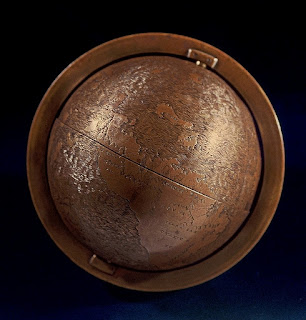One of the items on the list of 'things to do before I die' is to see the phrase
HC SVNT DRACONES on the Lenox Globe in person.
Hic sunt dracones means 'here be dragons'
in Latin. It is a phrase used to denote dangerous or unexplored territories, in imitation of the medieval practice of putting creatures in uncharted areas of maps.
The Hunt-Lenox Globe or Lenox Globe is the second or third oldest known terrestrial globe, after the Erdapfel of 1492. It is housed by the Rare Book Division of the New York Public Library. So there is a chance that I might be able to see it one day.
| The Hunt-Lenox globe was prepared around 1510 by an unknown artist and it was purchased in Paris in 1855 by architect Richard Morris Hunt, who gave it to James Lenox. This small hollow copper globe measures 112 millimetres (4.4 in) in diameter and 345 millimetres (13.6 in) in circumference. It is two parts, joined at the equator and held together by a wire strung through holes at the poles. It is notable as the only instance on a historical map of the actual phrase HC SVNT DRACONES (in Latin hic sunt dracones. The phrase appears on the eastern coast of Asia. It is the earliest surviving engraved copper sphere from the period immediately following the discovery of the New World. Of the two continents in the Western hemisphere, only South America is actually represented, appearing as a large island with the regional names Mundus Novus (the New World), Terra Sanctae Crucis (the Land of the Holy Cross), and Terra de Brazil (the Land of Brazil). Cuba appears as “Isabel,” and the island shared by the Dominican Republic and Haiti (Hispaniola) appears as “Spagnolla." North America is represented as a group of scattered islands.
Fascinating |

No comments:
Post a Comment